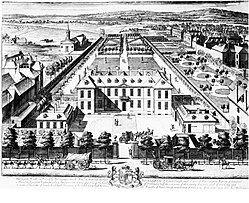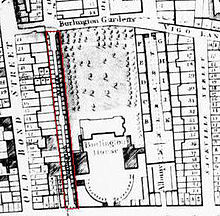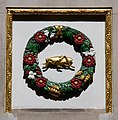
Burlington Gardens is a street in central London, on land that was once part of the Burlington Estate.
Location

The street is immediately to the north of the Royal Academy of Arts and joins Old Bond Street and New Bond Street in the west and Vigo Street in the east. Cork Street, Savile Row and Old Burlington Street all run north from Burlington Gardens.
On the south side of Burlington Gardens is one end of the Burlington Arcade and the rear of Albany at 10 and 12 Burlington Gardens, which is wedged between the end of Burlington Gardens and the start of Vigo Street. This part of Albany was designed by Henry Holland.
History
Burlington Gardens was once part of Vigo Lane (later renamed Vigo Street) which originally ran all the way from Bond Street to Glasshouse Street before the part behind Burlington House was renamed Burlington Gardens by 1831.
And before it was either Vigo Street or Lane, the whole roadway from what is now Bond Street to the current Glasshouse Street was called Glasshouse Street.
Listed buildings

Burlington Gardens contains a number of historic buildings. Both number six and number seven are Grade II* listed by English Heritage.
Atkinsons Building
Atkinsons Building, which includes 2 and 4 Burlington Gardens, is on the corner of Old Bond Street and Burlington Gardens. It was built in 1926 in the Gothic Revival style and includes Arts and Crafts detailing. It is Grade II-listed by English Heritage.
6 Burlington Gardens
6 Burlington Gardens is used by the Royal Academy and is the largest building in the street. It was built in 1866–67 on the garden of Burlington House to a design by Sir James Pennethorne. It was originally the headquarters of the University of London. From 1900 it was occupied by the Civil Service Commission. It then became the Museum of Mankind before being taken over by the Royal Academy. It has an Italianate facade, and the portico includes four statues by Joseph Durham of Newton, Bentham, Milton and Harvey, representing Science, Law, Arts and Medicine.
7 Burlington Gardens
7 Burlington Gardens is on the north side of the street and was built in 1721–23 to designs by the Italian architect Giacomo Leoni. It was first occupied by the Duke of Queensberry, and the poet John Gay also lived there. It was originally known as Queensberry House, but became Uxbridge House after the Earl of Uxbridge bought it in 1785. From 1785–89, it was extended by the architects John Vardy the Younger and Joseph Bonomi the Elder for Lord Uxbridge. It later became home to the Marquess of Anglesey, the Bank of England and the Royal Bank of Scotland. It was an Abercrombie & Fitch store, the first in Europe.
Shops in Burlington Gardens
- Abercrombie & Fitch. Fashion retailers.
- Blades. Men's fashion by Rupert Lycett Green. (closed)
- Ede & Ravenscroft. Ceremonial outfitters.
Gallery
-
 Atkinsons Building
Atkinsons Building
-
 Detail from Atkinsons Building
Detail from Atkinsons Building
-
 Detail from Atkinsons Building
Detail from Atkinsons Building
-
The Royal Warrants held by Ede & Ravenscroft displayed at their Burlington Gardens shop
-
 The north entrance to the Burlington Arcade
The north entrance to the Burlington Arcade
-
 6 Burlington Gardens, on the south side of the street. In use by the Royal Academy of Arts, it includes statues by Joseph Durham.
6 Burlington Gardens, on the south side of the street. In use by the Royal Academy of Arts, it includes statues by Joseph Durham.
-
 Queensberry (Uxbridge) House, c. 1790
Queensberry (Uxbridge) House, c. 1790
References
- ^ Hibbert, Christopher (2010). The London Encyclopaedia. London: Pan Macmillan. p. 115. ISBN 978-0-230-73878-2.
- "Plan your visit". Royal Academy of Arts. Retrieved 10 June 2014.
- Allinson, Kenneth (2013). Architects and architecture of London. Oxford: Architectural Press/Elsevier. p. 116. ISBN 978-1-136-42965-1.
- Wheatley, Henry B. (1891). London past and present: Its history, associations, and traditions. Vol. III. London: John Murray. Cambridge University Press reprint, 2011. p. 435. ISBN 978-1-108-02808-0.
- ^ Kingsford, Charles Lethbridge. (1925). The early history of Piccadilly Leicester Square Soho & their neighbourhood based on a plan drawn in 1585 and published by the London Topographical Society in 1925. Cambridge: University Press. p. 127.
- Historic England. "Ethnography Department of the British Museum (1291018)". National Heritage List for England. Retrieved 11 June 2014.
- Historic England. "Details from listed building database (1266364)". National Heritage List for England. Retrieved 3 June 2014.
- ^ The University of London at No. 6 Burlington Gardens: Stone Conduit Close Survey of London, Vol. 31 & 32: St James Westminster, Part 2 (1963), pp. 435–441. Retrieved 3 June 2014.
- Historic England. "Uxbridge House (1357241)". National Heritage List for England. Retrieved 3 June 2014.
- ^ Barriaux, Marianne. (19 March 2007). "Abercrombie & Fitch to open London shop". The Guardian. Retrieved 11 June 2014.
- "Abercrombie & Fitch". Time Out. 30 November 1999. Retrieved 12 June 2014.
- Musgrave, Eric. (2009). Sharp suits. London: Pavilion. p. 21. ISBN 9781862058521.
- Stores Ede & Ravenscroft, 2014. Retrieved 3 June 2014.
External links
 Media related to Burlington Gardens at Wikimedia Commons
Media related to Burlington Gardens at Wikimedia Commons
51°30′36″N 0°08′27″W / 51.5099°N 0.1409°W / 51.5099; -0.1409
Categories: